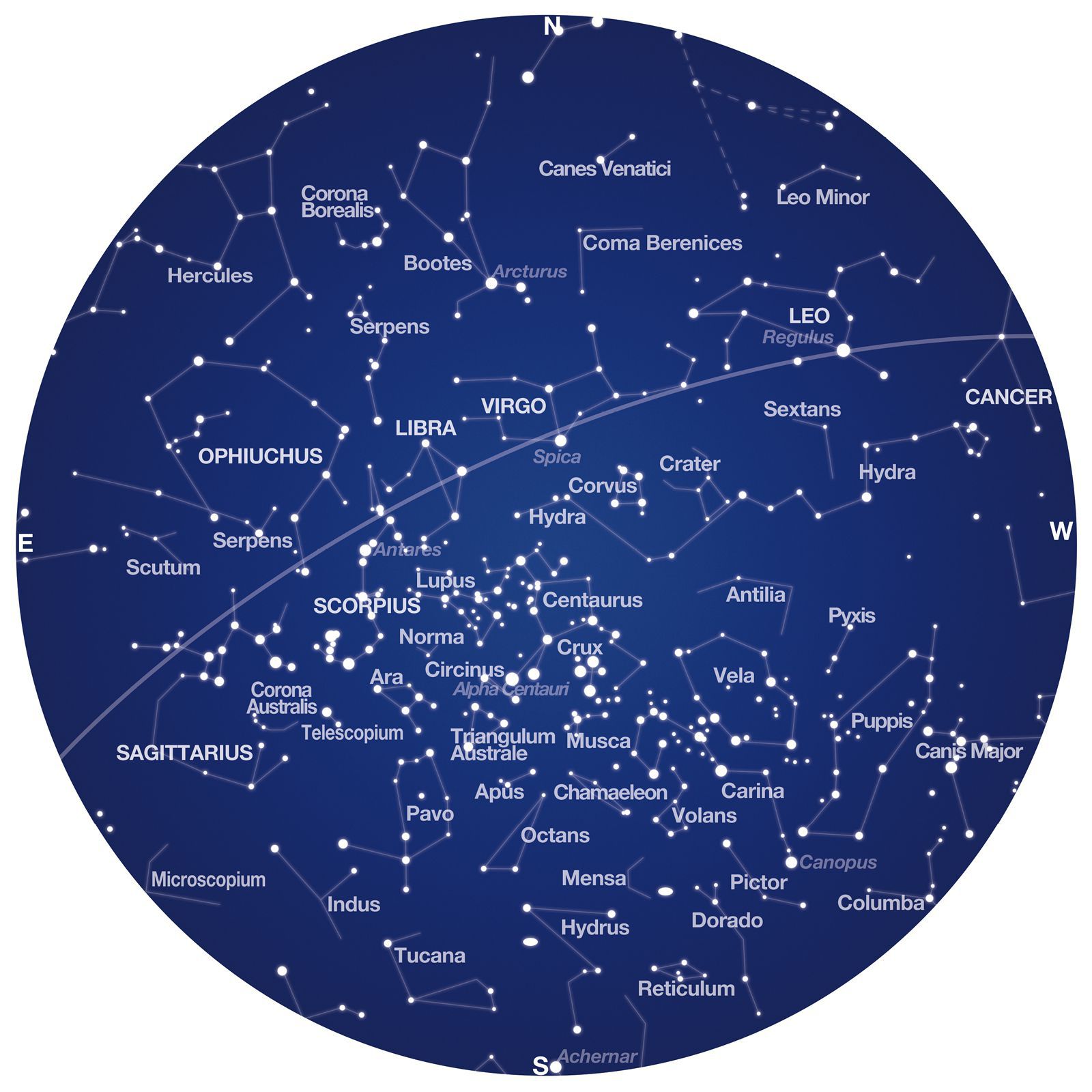
Monthly sky maps from the 2022 Australasian Sky Guide by Dr Nick Lomb, published by MAAS Media.
What’s in the sky this July?
Constellations
Constellations are groups of stars that represent mythological figures, fanciful beasts or old scientific instruments. Some have been used for millennia as a tool to share significant cultural stories and to track the passage of the weeks and months. Today, they also help astronomers delineate portions of the sky and locate astronomical objects. In July, in the early evening, these constellations dominate the sky:
- Scorpius – Appearing high in the eastern sky Scorpius, the Scorpion, is one of the brightest and most easily identifiable constellations. Recognisable by its hooked tail and the red supergiant star Antares at its heart, Scorpius is a pattern of stars that looks like its namesake. In Greek mythology, the scorpion plays a role in many stories, however it is best known for its pursuit of Orion, the Hunter, through the night sky.
- Sagittarius – Also known as the Archer, this centaur is found in the eastern sky below the tail of Scorpius on July evenings. In Greek mythology, Sagittarius points his arrow towards the heart of Scorpius. However, to many this constellation looks more like a teapot!
- Virgo – This giant constellation of the maiden is found in the north-western sky. It can be most easily found by locating the constellation’s brightest star, Spica. The rest of the figure is composed of relatively faint stars and looks little like a maiden.
- Southern Cross and Pointer Stars – Throughout the month the Southern Cross is high in the south-western sky near the two bright Pointer Stars of Alpha Centauri and Beta Centauri. This landmark of the southern sky points the way toward the south celestial pole.
- Centaurus – Surrounding the Southern Cross on three sides is the other centaur of the night sky, Centaurus. The Pointer Stars make up the front legs of the centaur. Centaurus is another large constellation including many highlights of the southern sky, including Alpha Centauri – the closest star system to the Sun – and the globular cluster Omega Centauri.
Planets
This month Mercury, Venus, Mars, Jupiter & Saturn appear in the morning sky. They make a fine sight before dawn, around 6am, when they are arranged in a grand parade across the sky, and remarkably in their correct order from the Sun! Mercury is low down in the North-East with bright Venus just above, look left to find reddish Mars in the North and then bright yellow Jupiter to the left of Mars, finally yellowish Saturn is in the North-West. Mercury also puts in an appearance in the evening sky.
If you have trouble identifying planets from stars the Moon comes to your aid during the month – see below.
The best time to view will be an hour or so before sunrise, or soon after sunset.
- Mercury – a pale whitish planet that never gets far from the Sun. This month Mercury spends the first few days of the month low in the North-East in Taurus shortly before sunrise. It soon descends and disappears from view behind the Sun. In the last few days of July this inner-most planet reappears just after sunset low in the North-West in Leo.
- Venus – easily recognizable as a very bright & white ‘spotlight’ above the North-Eastern horizon. Venus seems to be glued to this spot for the month as it slides from Taurus into Gemini.
- Mars – reddish, and much fainter than Venus, Mars remains in the northern sky all month drifting from Pisces into Aries.
- Jupiter – the King of the planets, bright & yellowish, begins the month in the north in Cetus, although it’s close to the border with Pisces. As the month progresses it drifts slowly westward with the constellations and ends the month in the North-Eastern sky.
- Saturn – yellowish like Jupiter but fainter, Saturn begins July in the west and spends the month slowly descending towards the horizon. It remains in Capricorn all month.
You may have noticed that the sky at dawn and dusk seems very bright at present – there’s a white glow covering much of the sky to the west after sunset, and to the east before sunrise. This is probably a result of the January eruption of the Hunga Tonga–Hunga Ha‘apai volcano in Tonga. The eruption hurled ash and gas into the stratosphere (the high atmosphere) where, like a thin hazy cloud, it is scattering sunlight down towards the ground, and to you. The resulting brighter sky will make it harder to spot planets and crescent Moons close (a handspan or so) to the horizon. And the ash may remain up there for months to come.
Moon
First Quarter is on Thursday 7th
Full Moon is on Thursday 14th
Last Quarter is on Thursday 21st
New Moon is on Friday 29th
Let the Moon be your guide to the planets this month. From the 16th to the 26th the Moon marks out the planets in the dawn sky. Again, view around 6am. On the 16th a waning gibbous Moon (just after Full phase) is just to the left of Saturn. On the 19th the still-gibbous Moon is just to the left of Jupiter. By the 22nd it is just below Mars. Finally, on the 26th a very thin crescent Moon floats to the left of Venus – a lovely dawn sight in the East.
Deep Sky
Explore the universe through your telescope or binoculars and take in some of the gems of the July winter sky, but dress warmly!
- Jewel Box open cluster – About 7000 light-years away, within the Southern Cross constellation, and not far from the “left-hand” star of the Cross, this open star cluster consists of thousands of young stars. Through a telescope many blue supergiants, and one distinctive red supergiant can be seen.
- Sombrero galaxy – Also known as M104 from the Messier Catalogue. This galaxy is 28 million light-years away and is situated within the constellation Virgo.
- Alpha Centauri star system – A star system consisting of three stars, Alpha Centauri A, Alpha Centauri B and Proxima Centauri. Proxima Centauri is the closest star to our Sun, at a distance of 4.2 light-years, it is a red dwarf star and is only visible through large telescopes.
- Omega Centauri globular cluster – The largest of about 150 globular clusters orbiting the Milky Way. Omega Centauri is 16,000 light-years away in the Centaurus constellation. It is estimated to have over 10 million stars and may even be the core of an ancient galaxy partially cannibalised by the Milky Way.
Other Events
In July 2022 also look out for the following,
July 4, Earth at aphelion – Earth reaches its furthest point from the Sun for the year, called aphelion. It happens at 5:11pm AEST, to be precise, when we are almost 152,098,400km from the Sun.
July 13, James Webb Space Telescope images released – just after midnight Sydney time (i.e. in the early hours of July 13) we get to see the first colour images from the new space telescope, albeit false colours given the telescope collects primarily infra-red light. We will find out just what this long-awaited telescope is capable of.
July 14, Supermoon – the Full Moon on July 14 is a supermoon. The best time to view will be as it rises on the 13th at 4:13pm AEST. There are several definitions of a supermoon, but all agree that it’s a Full Moon that occurs around the same time as the Moon is at its closest to Earth. The Moon’s elliptical orbit brings it close to Earth, called perigee, once each orbit. If perigee coincides with, or close to, a Full Moon then that Full Moon is a supermoon.
Perigee occurs on July 13 at 7:06pm AEST with the Moon 357,264km from Earth. Just 9.5 hours later, on July 14 at 4:38am AEST, the Moon is Full and 357,418km from Earth. This supermoon is the closest Full Moon of the year.
If you miss the Moonrise on the 13th, try Moonset at 7:27am on the 14th.
Learn More
- Purchase the 2022 Australasian Sky Guide by Dr Nick Lomb, featuring an annual report of what’s in the sky and the latest astronomical findings. Produced by MAAS Media.
- View the StarMap 07 July 2022, which shows the stars, constellations and planets visible in the night sky from anywhere in Australia
- Check out these resources for getting started



Andrew, thanks very much for your response and guidance.
Regards Strachan
What about comet K2 how can we see it?
Strachan, Comet C/2017 K2 (PANSTARRS) is visible in the constellation Ophiuchus at present, roughly near the middle of the large loop/arc of Ophiuchus seen in our July star map. You will need binoculars at least to see it, and a dark sky away from city lights. Look for a ‘fuzzy star’ – I doubt you will see any tail. It reaches its closest point to Earth (although still almost twice as far away as the Sun!) on about July 14. There is more information here, but beware of the northern hemisphere bias!
Thanks Andrew, greatly appreciate the guidance